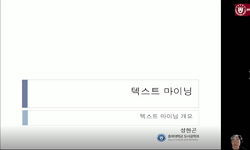본 연구는 원자력안전법의 규제 대상인 의료기관(진료 목적의 방사성동위원소 또는 치료 목적의 방사선발생장치 사용기관)의 최근 약 20년간의 정기검사 지적사항에 대한 내용을 분석하여 ...
http://chineseinput.net/에서 pinyin(병음)방식으로 중국어를 변환할 수 있습니다.
변환된 중국어를 복사하여 사용하시면 됩니다.
- 中文 을 입력하시려면 zhongwen을 입력하시고 space를누르시면됩니다.
- 北京 을 입력하시려면 beijing을 입력하시고 space를 누르시면 됩니다.

의료기관 방사선안전관리 실적에 기반한 문제 분류체계 도출 및 현황 평가: 토픽모델링 기법 적용 = Deriving Problem Classification System and Evaluating Current Status based on Inspection Results of Radiation Safety Management in Medical Institutions: Application of Topic Modeling Technique
한글로보기https://www.riss.kr/link?id=A108967690
- 저자
- 발행기관
- 학술지명
- 권호사항
-
발행연도
2024
-
작성언어
Korean
- 주제어
-
등재정보
KCI등재
-
자료형태
학술저널
-
수록면
255-276(22쪽)
- 제공처
-
0
상세조회 -
0
다운로드
부가정보
국문 초록 (Abstract)
본 연구는 원자력안전법의 규제 대상인 의료기관(진료 목적의 방사성동위원소 또는 치료 목적의 방사선발생장치 사용기관)의 최근 약 20년간의 정기검사 지적사항에 대한 내용을 분석하여 의료기관에 내재되어 있는 방사선안전관리의 취약성을 분류하고 평가할 수 있는 방법론을 도출하고자 하였다. 이를 위해, 토픽모델링 방법 중 LDA(Latent Dirichlet Allocation, 잠재 디리클레 할당) 모형을 활용하여 의료기관 방사선안전관리 상에 존재하는 문제와 관련한 6개의 토픽을 도출하였으며, 토픽을 구성하는 단어 조합과 토픽별 4M(Man, Machine, Media, Management) 분포를 보완적으로 활용하여 각 토픽이 의미하는 문제 유형을 식별하였다. 분석 결과, 방사선안전관리 문제 유형은 대분류로는 방사선원, 방사선작업종사자로 구분되며, 소분류로는 방사성동위원소 관리, 방사선발생장치 관리, 방사선량률 등 측정・기록 관리, 방사성폐기물 관리, 인적 관리체계 및 행위 관리체계로 분류할 수 있었다. 즉, 단순 빈도 기반의 키워드 분석으로는 찾을 수 없었던 문제 분류체계를 제시할 수 있었다. 또한 모든 토픽 집합에서 가장 큰 비중을 차지하는 것은 4M 프레임워크 상에서 관리적(Management) 요인으로 나타났다. 이는 국내 의료기관 방사선안전관리 제고를 위해서는 안전한 작업 절차를 개발하고 준수할 수 있는 체계를 마련하는 것이 필요하다는 것을 시사한다. 또한 토픽 비중이나 시점별 토픽 비중 변화를 살펴보면 방사성동위원소와 폐기물에 대한 관리 문제는 꾸준하게 높은 비율로 발생되고 있으므로 방사성동위원소의 취급 및 폐기물에 대한 관리가 의료기관의 방사선안전관리에서 가장 중요한 요소임을 시사한다.
다국어 초록 (Multilingual Abstract)
This study aims to derive a methodology for classifying and evaluating the vulnerabilities of radiation safety management in medical institutions, which is regulated under the Atomic Energy Safety Act in South Korea, by analyzing the official document...
This study aims to derive a methodology for classifying and evaluating the vulnerabilities of radiation safety management in medical institutions, which is regulated under the Atomic Energy Safety Act in South Korea, by analyzing the official document containing the results of regular inspection over the past 20 years. To this end, this study employs the latent Dirichlet allocation model, a topic modeling technique, and derives six topics related to problems in radiation safety management in medical institutions. In addition, the study complementarily used the word combinations comprising the topics and the 4M (Man, Machine, Media, Management) distribution of each topic to identify meaning of each topic. As a result, the types of radiation safety management problems were categorized into “radiation sources” and “radiation workers”. Detailed problem types were identified as “radioisotope management”, “radiation generator management”, “measurement and record management”, “radioactive waste management”, “personnel management system”, and “behavior management system”. In other words, this study derived a problem categorization system that could not be found by simple frequency-based keyword analysis. In addition, it is revealed that the “management” factors in the 4M framework accounted for the largest proportion of all topic sets. This suggests that developing safe work procedures and establishing systems to ensure compliance are necessary to improve radiation safety management in Korean medical institutions. Furthermore, when looking at the proportion of topics and changes in the proportion of topics over time, it was observed that the management of Radioisotopes and waste was consistently high. This result suggests that the handling of radioisotopes and waste management are the most important aspects of radiation safety management in Korean medical institutions.
동일학술지(권/호) 다른 논문
-
- 한국혁신학회
- 허원창
- 2024
- KCI등재
-
- 한국혁신학회
- 안현정
- 2024
- KCI등재
-
산업혁신체제 관점에서의 바이오 육성정책 및 성과분석:생명공학육성기본계획을 중심으로
- 한국혁신학회
- 김경남
- 2024
- KCI등재
-
지속가능한 탄소중립 기술혁신을 위한 공동연구 네트워크 성과 분석 및 시사점 발굴
- 한국혁신학회
- 박지혜
- 2024
- KCI등재




 KCI
KCI DBpia
DBpia



